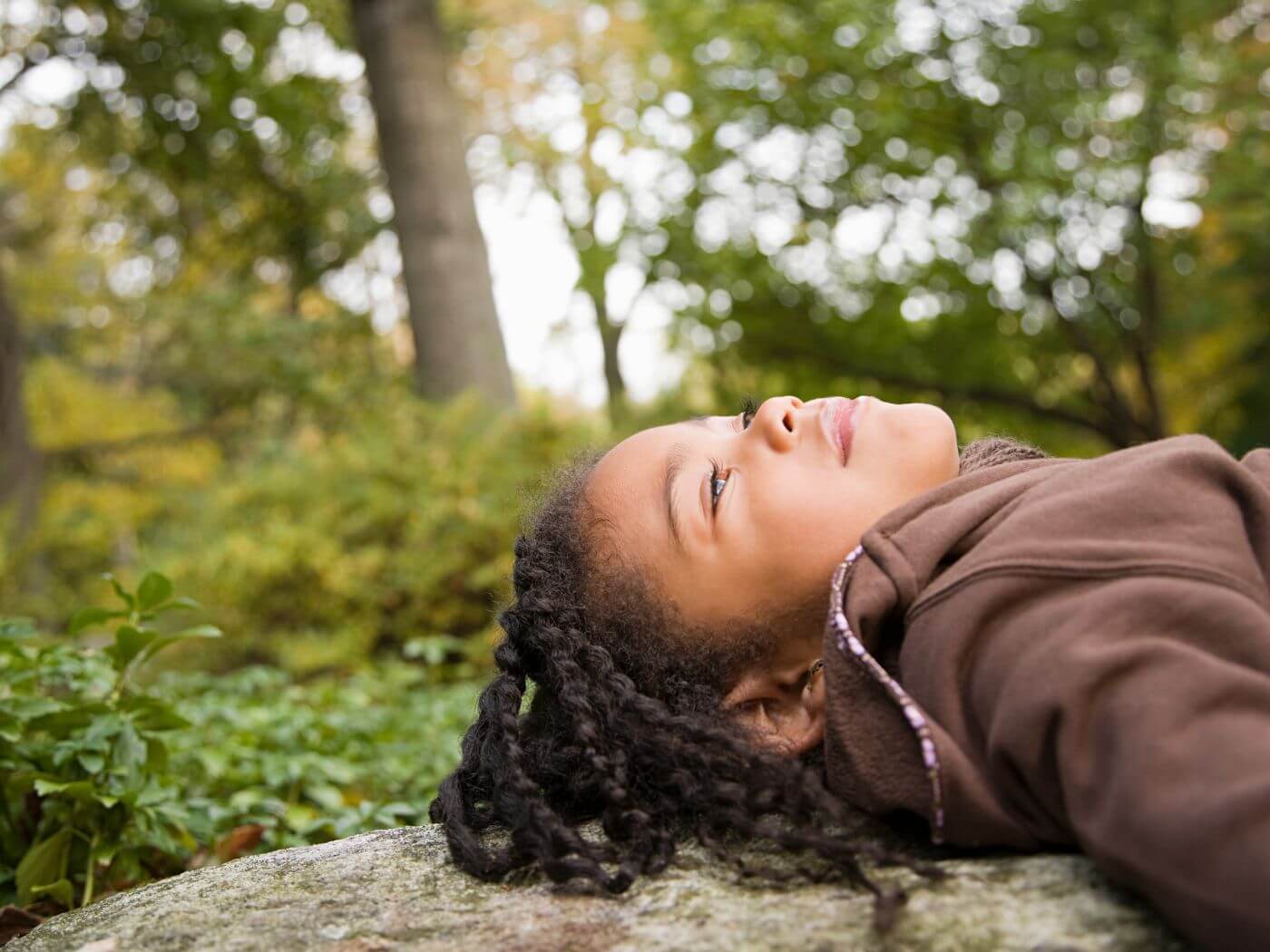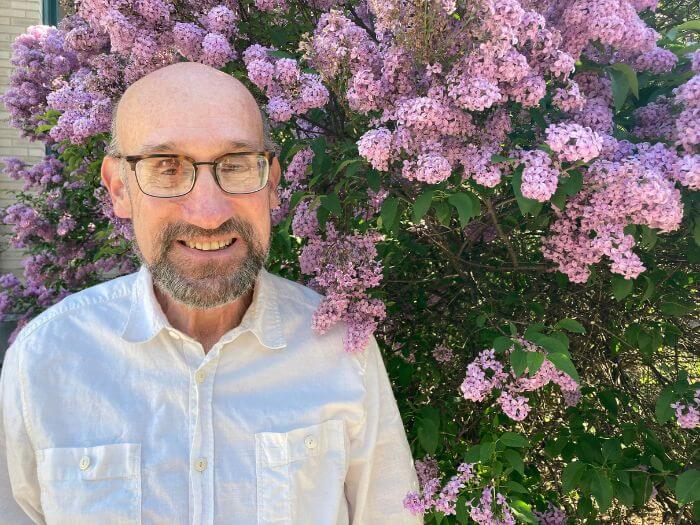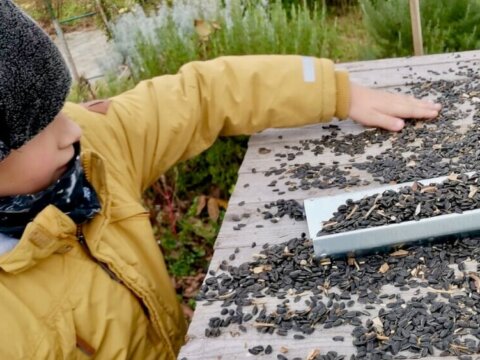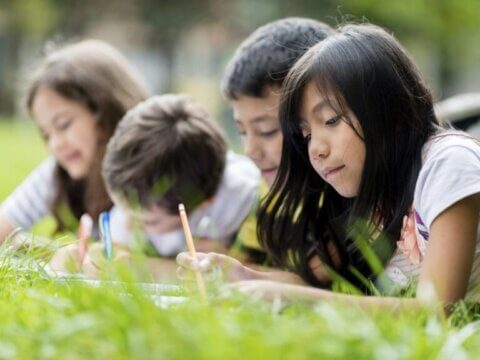Ecological Grief and Hope in a Changing World
Destructive floods in Kentucky; historic droughts in the southwest; unprecedented temperatures in Washington and Oregon. It’s hard to see these headlines and feel that all is well with the planet. When coupled with reports of massive losses in bird, mammal, and plant species, many of us choose to bury our heads in the proverbial sand, and conclude that our environment is doomed.
This overwhelming sense that environmental systems are irreparably in decline has been labeled as ecological grief (1). While grief has traditionally been associated with the loss of a loved one, ecological grief can manifest in similar ways — from sadness, distress and despair, to anger, fear and helplessness. Not only are these emotions debilitating to the individual, they tend to inhibit taking any action to overcome the grieving state.
Spending time in nature has long been associated with positive impacts on our mental and physical well-being (2, 3, 4). Nature experiences can lower cortisol levels, blood pressure and heart rate, while increasing memory recall, ability to concentrate and sleep patterns. From very young children to seniors in their final decades of life, time in nature is a vital component of a healthy, balanced life (5).
But do these same benefits still hold when one hikes in a forest that has been devastated by wildfire, or watches monarch butterflies pollinating flowers after reading about their decline? Can nature engagement help people to overcome their ecological grief and develop a sense of hope in our collective future?
Can nature engagement help people to overcome their ecological grief and develop a sense of hope in our collective future?
Hope is an elusive, fragile state. Emily Dickinson spoke of hope as the thing with feathers — like feathers, hope can easily be blown away. When we hope for things to improve without any sense of how that can occur, we really are just wishing. To be meaningful, a hope must carry with it a plan for how it will be achieved. To counter ecological grief, one must not only envision a more positive future, but also the actions needed to achieve it. Hope psychologist C. R. Snyder described this as a three-step process: envisioning a positive goal, developing a pathway to attain it, and motivating oneself to follow that pathway (6).
To counter ecological grief, one must not only envision a more positive future, but also the actions needed to achieve it.
Children’s involvement with nature
Much recent research has confirmed the importance of young people having regular experiences in nature. As described in the report, Home to Us All: How Connecting with Nature Helps Us Care for Ourselves and the Earth (7), children’s involvement with nature is essential both for their own social and intellectual development, and for the preservation of biodiversity on the planet.
When children engage with the natural world, they are more likely to develop pro-environmental practices as they mature into adolescence and adulthood (8, 9). Moreover, as young children move into adolescence, they are more likely to be influenced by their best friends’ pro-environmental attitudes than by their parents (10, 11). So a teenager is more likely to go on a weekend hike through a forest if it is suggested by a close friend than if it’s proposed by a parent.
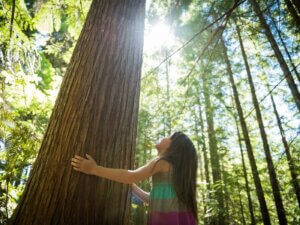 Photo courtesy of iStock.com/stockstudioX
Photo courtesy of iStock.com/stockstudioX
How can young people feel hope?
When young people believe that they and others can address environmental problems effectively, they are more likely to feel hope. Both hope and concern motivate action, whereas despair and feelings of helplessness are negatively related to action (12). Louise Chawla is an environmental psychologist and member of the Children & Nature Network scientific advisory council who has spent decades exploring the role of nature in childhood development. Chawla has stated that, though connection to the natural world can spur action on environmental issues, we do not yet know if this holds true for young people who feel acutely threatened by environmental problems such as climate change (13). When it comes to young people, do the negative effects of despair serve to outweigh the positive effects of nature connection?
The answer may lie in the type of hope we instill in our children. A study of Swedish high school students identified two kinds of hope: constructive hope and hope based on denial. The former acknowledges young people’s concerns and worries, while providing an achievable approach to addressing them. In contrast, hope based on denial of environmental challenges is unrealistic and takes us back to the realm of wishing without reason. In this study, students who based their hopes on denial of climate change were less inclined to behave pro-environmentally and perceived their teachers as not taking their emotions seriously (14).
To help young people feel environmental hope, adults need to understand and support them as they experience a full range of emotions regarding our environment.
Building on this concept of constructive hope, Chawla argues that for children to develop a comprehensive view of human connectedness with nature, they must feel supported in their full range of emotions. Adults therefore need to understand how young people cope with disturbing environmental information, and how to help them integrate positive and negative experiences (13). Young people are also quite attuned to both the attitudes and actions of adults in their lives. If they sense that parents, teachers, or other authority figures are professing pro-environmental attitudes, but then follow practices that are detrimental to the environment, they can lose faith in these adults as role models and, even worse, become cynical about the potential for improvement.
Collective vs. individual action
A recent large-scale study focused on climate change anxiety among a group of nearly 500 18 to 35 year olds in the U.S. Responses showed that the majority of participants felt frustrated or embittered by the decades of environmental indifference and inaction on the part of corporations and government agencies. Respondents were very worried about the environment, but their ecological grief left them feeling impotent to affect change. But this same study found that when participants engaged in collective, rather than individual action, they felt some capacity to protect themselves against depression (15). Therefore, when parents, educators and counselors provide young people with opportunities to engage in collective action, youth can experience a true restoration of hope — allowing them to identify goals and a path of action, and reclaim a sense of agency and connection (15).
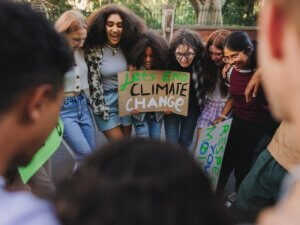 Photo courtesy of iStock.com/jacoblund
Photo courtesy of iStock.com/jacoblund
And yet, even engaging in a collective action, such as petitioning to have a school adopt entirely recyclable and compostable materials, can often feel insignificant to pre-teens and adolescents when compared to the enormity of the situation. As with all emotions that young people express, these must be addressed seriously by adult mentors. An appropriate response might be, “Yes, this action is small, but if thousands of groups across the country and across the globe convince their schools to eliminate waste, then collectively you will all have had tremendous impact.”
In the burgeoning days of the environmental movement, a popular catchphrase was, “Think globally, act locally.” This is truer today than it was 50 years ago, and the local needs, wherever one resides, are enormous. By taking action, and seeing those actions make discernible difference, children and youth can have their hope for a healthier, more diverse environment restored. And as long as there is hope, there is possibility.
References
- Cunsolo, A., Ellis, N.R., (2018). Ecological grief as a mental health response to climate change-related loss. Nature Climate Change, 8, 275–281. DOI: 10.1038/s41558-018-0092-2
- Bratman, G.N., Hamilton, P., Hahn, K.S., Daily, G.C., Gross, J.J., (2015). Nature experience reduces rumination and subgenual prefrontal cortex activation. PNAS, 112(28), 8567-8572. doi: 10.1073/pnas.1510459112. Read more.
- Kuo, M., (2015). How might contact with nature promote human health? Promising mechanisms and a possible central pathway. Frontiers in Psychology, 6. DOI: 10.3389/fpsyg.2015.01093. Read more.
- Frumkin, H., Bratman, G.N., Breslow, S.J., Cockran, B., Kahn, P.H., Lawler, J.J., Levin, P.S., Tandon, P.S., Varanasi, U., Wolf, K.L., Wood, S.A., (2017). Nature contact and human health: A research agenda. Environmental Health Perspectives, 125(7). DOI: 10.1289/ehp1663. Read more.
- Louv, Richard. (2008). Last Child in the Woods: Saving our Children from Nature-Deficit Disorder. Chapel Hill, NC: Algonquin Books.
- Snyder, C.R. (2009). TARGET ARTICLE: Hope Theory: Rainbows in the Mind. Psychological Inquiry 13(4). DOI: 10.1207/S15327965PLI1304_01
- Charles, C., K. Keenleyside, R. Chapple, B. Kilburn, P.S. van der Leest, and D. Allen. (2018). Home to us all: How connecting with nature helps us care for ourselves and the earth. Minneapolis, MN: Children and Nature Network.
- Meredith, G.R., Rakow, D.A., Eldermire, E.R.B., Madsen, C.G., Shelley, S.P., Sachs, N.A., (2020). Minimum time dose in nature to positively impact the mental health of college-aged students, and how to measure it: A scoping review. Frontiers in Psychology, 14. DOI: 10.3389/fpsyg.2019.02942. Read more.
- Evans, G.W., Otto, S., Kaiser, F.G., (2018). Childhood origins of young adult environmental behavior. Psychological Science, 29(5): 679-687. DOI: 10.1177%2F0956797617741894. Read more.
- Collado, Silvia, Gary W. Evans, and Miguel A. Sorrel. (2017). The role of parents and best friends in children’s pro-environmentalism: Differences according to age and gender. Journal of Environmental Psychology, 54: 27-37. DOI: 10.1016/j.jenvp.2017.09.007. Read more.
- Duarte, R., Escario, J-J., Sanagustin, M-V., (2017). The influence of the family, the school, and the group on the environmental attitudes of European students. Environmental Education Research, 23(1), 23-42. DOI: 10.1080/13504622.2015.1074660. Read more.
- Li, C. J., Monroe, M.C., (2019). Exploring the essential psychological factors in fostering hope concerning climate change. Environmental Education Research, 25(6), 936–954. DOI: 10.1080/13504622.2017.1367916.
- Chawla, L., (2020). Childhood nature connection and constructive hope: A review of research on connecting with nature and coping with environmental loss. People and Nature, 619-642. DOI: 10.1002/pan3.10128. Read more.
- Ojala, M. (2015). Hope in the face of climate change: Associations with environmental engagement and student perceptions of teachers’ emotion communication style and future orientation. Journal of Environmental Education, 46(3), 1–16. DOI: 10.1080/00958964.2015.1021662.
- Schwartz, S. E., Benoit, L., Clayton, S., Parnes, M. F., Swenson, L., & Lowe, S. R. (2022). Climate change anxiety and mental health: Environmental activism as buffer. Current Psychology, 1-14. DOI: 10.1007/s12144-022-02735-6.
Voices: Imagine a newer world: A Vision of a Nature-Rich Future, One We Can Create Together, by C&NN co-founder Richard Louv
Research Digest: Children and climate change activism
Research Digest: Nature and young people as environmental leaders
Feature: Earth Day — Young leaders advocate for change
Infographic: Green schoolyards and mental health benefits
Voices: Choosing hope, by C&NN President Sarah Milligan-Toffler
-
Network News
POLICY UPDATE: Policy and advocacy for the children and nature movement
-
Voices
Binoculars, bald eagles and my journey as a Black birder
-
Richard Louv
THE WONDER BOWL: Ten Spring and Summer Nature Activities for Kids and Adults
-
Network News
Minneapolis Spotlight: The promise and possibilities of parks for youth
-
Voices
Why nature is my motherhood ally


